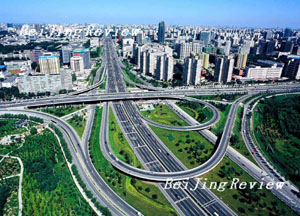
Seven million. That's the number of tickets the Beijing Organizing Committee for the Games of the 29th Olympiad (BOCOG) expects to sell to audiences flooding into the capital during the Olympics in 2008.
Logistically, the flow of people could be a nightmare, most significantly the challenge placed on the transportation system.
"I am sure that we have the ability to manage transportation during the Olympic Games," said Yu Chunquan, Deputy Director of the Beijing Traffic Management Bureau.
In 2004, Yu was invited by the International Olympic Committee (IOC) to be an observer of the Athens Olympic Games. "The Greeks had an efficient method of managing traffic and guaranteeing sound and convenient Olympic transportation," he said. "We also have our own set of measures, but that is just one aspect. More important is to provide people with good public transportation products, for instance, orbit transportation."
Orbit transportation
BOCOG has long had a special department in charge of transportation issues. This transportation department will enact transportation plans, coordinate and organize Olympic transportation. BOCOG President Liu Qi, said that Beijing is striving to take the necessary measures to ease the currently congested traffic situation in the city so as to fulfill the requirements of holding an Olympic Games.
"The first thing is to speed up the infrastructure construction of transportation," said Liu. Currently, four orbit transportation systems are under construction, including a light rail from the capital airport to Dongzhimen subway. Additionally, Beijing will further expand the usage of the Bus Rapid Transit system.
Despite the large area and the scattered Olympic stadiums, Beijing has already made commitment to the IOC that the Olympic Special Line will transport athletes to half of the stadiums within 20 minutes, and no more than 30 minutes to the rest.
To guarantee smooth transportation during the Olympic period, Beijing, like other hosting cities, may adopt certain measures to temporarily control the traffic flow in Olympic areas, major streets and roads. Meanwhile, a special Olympic lane will be demarcated.
During the Games, priority will be given to public transportation vehicles and people with an official Olympic ticket can get a free ride. A bicycle lane will be built in the Olympic village to encourage people to use bicycles, which are environmentally friendly. What's more, no major parking lots will be built around the Olympic stadiums, forcing spectators to use public transportation to reach these venues.
Traffic jams
However, as is known to all, it is no easy job to solve the traffic jams that have plagued Beijing for years.
"The Beijing transportation system has structural limitations," said Yu Chunquan. Other experts also believe that the transportation network in Beijing is very constricted. They point out that there are no major south-north streets, placing a heavy traffic burden on the second and third ring roads; no major roads are being built connecting urban and suburban areas; and the ring roads and cloverleaf junctions cannot meet the requirements for mass traffic flow.
Yu said that Beijing has been building roads and rail lines each year, however, the structural problem is deeply rooted. For instance, 800 meters of one of the major roads from Jianguomen to Chaoyangmen (from south to north) has not a single intersecting east to west lane. It is reported that in Tokyo, the average distance between major intersecting roads is 270 meters, in Paris it is 300 meters, but that of Beijing reaches an astounding 1,000 meters.
The short-sighted and old-fashioned city planning mentality is considered to be a major reason for the current traffic situation.
As a matter of fact, there are fewer cars in Beijing than in many other metropolitan areas in the world, but the utility ratio of Beijing's cars is much higher, about twice as high as that of Tokyo and Paris. The huge car flow again overburdens the fragile transportation system.
Beijing is working frantically to build new main roads and other traffic lanes connecting communities in an effort to improve the traffic quality. By 2008, 15 roads will have been built to connect the bus rapid transit lanes, which will extend to over 320 kms.
However, experts point out that it is not realistic to solve the Beijing traffic jams only by building more above-ground roads. Lu Huapu, a professor with Tsinghua University, noted that the capital's subway system only carries 10 percent of the total daily human traffic, while the figures of New York and Tokyo reach 80 percent and 40 percent respectively. Currently, the total operational length of orbit transportation is 114.1 kms. "A good-news factor is that the figure will surpass 300 kms in 2008," said Lu.
"We should also be using advanced science and technology measures to upgrade our transportation management level," stated Jiang Xiaoyu, BOCOG Vice Chairman. It is reported that Beijing will make full use of telecommunications, information and control technology to coordinate all departments relating to transportation, so as to build an integrated, intelligent transportation system.
During the Olympic Games, the intelligent traffic coordination system will be used to guide the traffic flow and public transportation information will be publicized on the Internet. More traffic signs and information display boards will also be put up for the convenience of all visitors.
| 